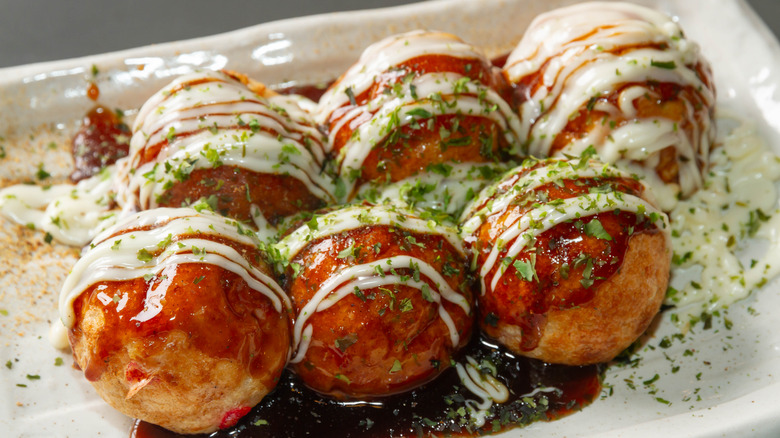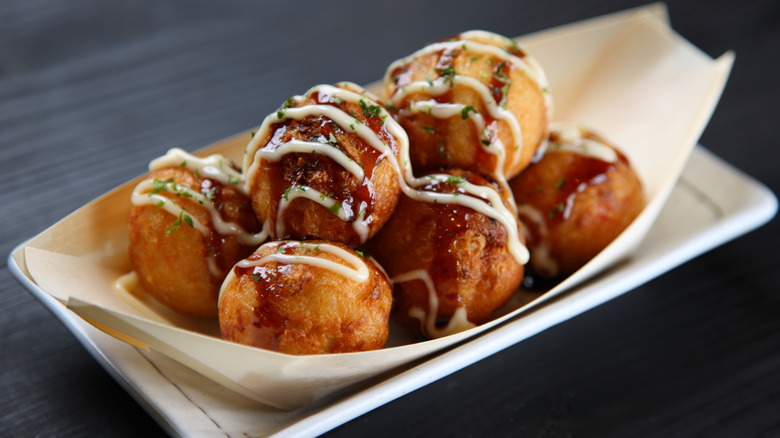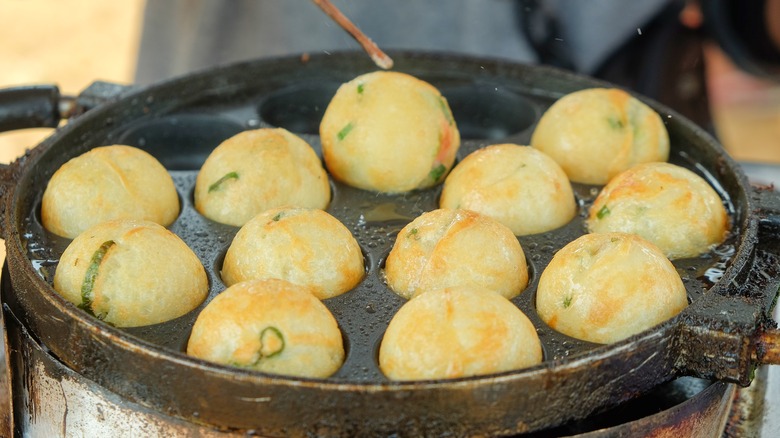What Exactly Is Takoyaki, And What Usually Goes Into It?
Though Japanese food is often known around the world for its delicate, delicious flavors and colorful presentation of dishes like sushi and sashimi, it's also a cuisine with no shortage of tasty appetizers. From the ever-versatile edamame to the colorfully-named Japanese okonomiyaki (which translates to "whatever you want, grilled") to the deceptively simple tempura vegetables, there are many great starters at Japanese restaurants. And one that's been gaining steam globally for years now is takoyaki.
Though they're both food items, "tako" and "taco" are pretty obviously different things, and "tako" in Japanese means "octopus" (another reminder that there are only so many sounds out there). That gives a pretty strong clue as to what takoyaki is: Fried orbs (roughly golf ball-sized) made out of wheat batter and octopus-based filling and served with various toppings. Though there's not one unified version of takoyaki, thanks to the variety of accouterments and fillings, the core remains fried octopus balls — and they're delicious.
Takoyaki can contain a lot of different ingredients
As far as the ingredients involved in takoyaki, they vary quite a lot. Though the base of the batter is relatively universal — eggs and flour combined with the bonito flake and dried kelp mixture known as dashi — and diced octopus is considered a requisite component, the filling can vary quite a bit. You might see takoyaki containing green onion, scraps of tempura, pickled ginger, or all of the above.
Just as important as the fillings for takoyaki are the toppings added after they're done cooking. There's not one standard array here, but there are a number of classic takoyaki add-ons: dried bonito flakes, Japanese mayo, seaweed, and the signature takoyaki sauce. Takoyaki sauce is especially worth noting because there's nothing else quite like it. It's often compared to Worcestershire sauce, but it's both sweeter and has more of a soy flavor. Takoyaki is often served with all of these toppings at once. The result of all these contrasting flavors is a dish quite unlike anything else you can find: A combination of fried pillowy dough, delicate, scallop-like octopus, and that mixture of toppings that enhance rather than clash with each other.
Takoyaki are cooked in a special pan
Despite the literal translation of their name as "grilled octopus," the cooking method for takoyaki doesn't involve grilling but rather pan frying. Most often, they're fried using a pan designed specifically for the purpose, which contains depressions into which the balls are inserted. Since only half of the individual takoyaki are fully exposed to the heat at one time, they have to be flipped partway through the cooking process.
Unlike a lot of foods, we actually have a name to associate with the creation of takoyaki: Endo Tomekichi. A street vendor in Osaka, Endo started serving a progenitor of takoyaki in 1935 called "choboyaki" — essentially very similar to takoyaki (though not necessarily with octopus), but with a flat rather than round shape. From there, he began experimenting with changing the shape until he got to the round balls we know today, and takoyaki was born. It's also no surprise that takoyaki is one of the many great Japanese foods that started as street food, a description that also applies to sushi.
If you've never tried takoyaki before, they're a bit of a singular experience. Give them a shot the next time you see them on a restaurant menu, and you won't be disappointed.


